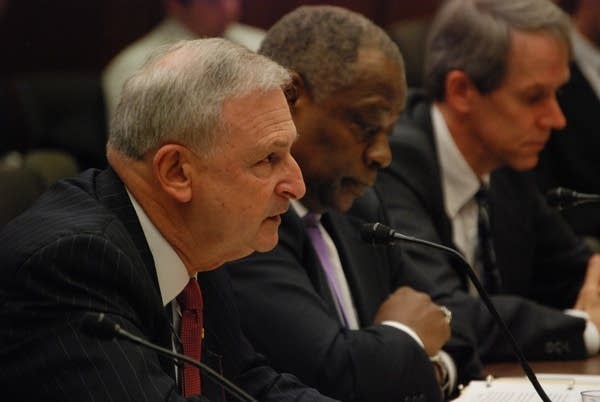Oberstar, NTSB chairman clash on bridge investigation
Go Deeper.
Create an account or log in to save stories.
Like this?
Thanks for liking this story! We have added it to a list of your favorite stories.

Every three years the NTSB goes before the Transportation Committee for funding reauthorization. Normally these hearings are a brief and quiet affair. But with the collapse of the 35W bridge collapse as a back drop, this hearing was more tense. Oberstar opened by telling NTSB Chair Mark Rosenker that the board's decision NOT to hold a hearing indicated that the board was understaffed and not interested in gathering the views of outside experts.
"There is huge skepticism about the objectivity of the board in conducting this inquiry," he said. "And I'm not asking you, I'm telling you that a public hearing will dispel, go a long way to dispel, the questions raised and the lack of trust in the board's actions."
In March, the NTSB board voted three to two against holding a public hearing. The vote was split down party lines, with Rosenker and the board's two other Republicans voting against a hearing.
Typically, a hearing is held for two reasons: to educate the public and gain information from outside experts. NTSB staff argued that in this instance holding a hearing would slow down the investigation. A slower investigation, they argued, would likely prompt MnDOT to move ahead with its own investigation. Some NTSB officials expressed concern the federal agency would lose control of the investigation.
Turn Up Your Support
MPR News helps you turn down the noise and build shared understanding. Turn up your support for this public resource and keep trusted journalism accessible to all.

Leaders and residents in Minnesota and elsewhere questioned whether speed was the real motive behind the NTSB's decision not to hold a hearing, Oberstar said.
"This was one of a class of bridges of which there are 740. We haven't had a public hearing on a bridge failure in over 20 years. This is an opportunity for a teaching moment and a learning moment for the board and for the staff. And I ask you to go back and reconsider it," Oberstar said.
NTSB Chairman Mark Rosenker, who has been the target of Oberstar's criticism in the past, responded by calling Oberstar a persuasive man.
"I don't enjoy being in your dog house, believe me. I must also tell you, this decision was one of the toughest ones, matter of fact as far as my career at the NTSB this was the toughest decision I've had to make. There are 13,000 steel truss bridges across the United States, give or take a few hundred. There are 50 state DOTs waiting for what we find in this investigation," he said.
Rosenker did not commit to reconsidering the board's decision on the public hearing. However, he did tell Oberstar the computer model of the bridge that NTSB has been working on will be done by June or July. This computer modeling is a big part of the agency's investigation. Rosenker said more data will be made public in the next few weeks. He also promised complete openness when the final conclusions of the investigation are released later this year.
"We will be doing, Mr. Chairman, an excellent presentation, an excellent sunshine presentation where this will get a public airing like nothing we have done before, sir. When this is complete and there will be peer review ad nauseum in relation to that," Rosenker said.
Rosenker refused any additional comment following his testimony.
Oberstar's criticism of the agency comes at a time when the NTSB is stretched thin. The highway division of the NTSB that is investigating the 35W bridge collapse is the smallest unit of the agency. The agency's overall budget hasn't been increased in several years, but Chairman Rosenker didn't ask for an increase in funding for next year.
Both Rosenker and his predecessor have been criticized for politicizing the agency. It's also been criticized for its lack of expertise in transportation.
Dear reader,
Political debates with family or friends can get heated. But what if there was a way to handle them better?
You can learn how to have civil political conversations with our new e-book!
Download our free e-book, Talking Sense: Have Hard Political Conversations, Better, and learn how to talk without the tension.





